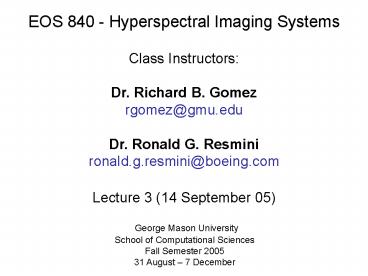14 Sep 05 Lecture 3 PowerPoint PPT Presentation
1 / 16
Title: 14 Sep 05 Lecture 3
1
EOS 840 - Hyperspectral Imaging Systems
Class Instructors Dr. Richard B.
Gomez rgomez_at_gmu.edu Dr. Ronald G.
Resmini ronald.g.resmini_at_boeing.com
Lecture 3 (14 September 05)
George Mason University School of Computational
Sciences Fall Semester 2005 31 August 7
December
2
Contact Information
Ron Resmini v 703-735-3899 ronald.g.resmini_at_boein
g.com (Please put EOS840 in Subject Line) Office
hours by appointment
3
Outline
- Review/context/a thread...
- Introduction to radiative transfer theory
- The atmosphere
- Spectral/spatial analysis
- HSI and the ENVI s/w system
4
Review/Context/A Thread...
- HSI RS is based on the measurement of a physical
quantityas a function of wavelength its
spectroscopy - HSI is based on discerning/measuring the
interaction oflight (photons, waves) with matter - A thread from Maxwells equations to...
- Fresnels equations which describe...
- Interaction of EMR with materials
- Ideal, simple configurations of materials
- Ideal, simple conception of RT processes
- No atmoshpere
- View RT as modeling fluxes or radiometric
quantities - We want to describe RS within/through an
atmosphere of... - Complicated materials, mixtures, real surfaces
- Complicated interactions of EMR within the RS
scenario
5
Review/Context/A Thread...Why?
- We ultimately want to focus on HSI applications
- Many applications are earth RS through/within the
atmosphere - Data are collected by sensor systems
- The data are calibrated (spectrally and
radiometrically) - Other corrections/fixes may need to be applied
- Apply atmospheric correction (maybe not all the
time, though) - Apply information extraction algorithms
- Spectral libraries
- Apply information and/or data fusion
- Apply geometric processing e.g.,
orthorectification - Product generation report writing
- Disseminate, publish, archive
- Plan and conduct future data collection and
exploitation - Repeathaving learned more from the process!
6
Introduction to Radiative Transfer (RT) Theory
- The RT equation (see next slides)
- Simplified expressions get you gt90 of whatyou
need to know - Radiometry and radiation propagation
- Coordinates frames of reference principal
plane, etc. - Illumination angle, direction
- View angle, direction
- Phase angle
- Azimuth, relative/absolute
- Its easier if we adopt an earth RS scenario
- But...simplified models are very helpful e.g., a
layerof gas and/or aerosols isolated in space...
7
The Radiative Transfer Equation
Eq. 7.21 on pg. 156 of Hapke (1993).
Arghhhhh!!!!
8
On the following
9
Some Simplified RT Expressions
- RT can be (and in practice is) viewed as an
accountingof terms based on radiance
interactions in the RS scenario - Bear in mind, however, that there is a link
between theterms in the accounting and solutions
to the RT equation - The accountings can be as simple or as
complicated asnecessary to address the RS
question(s)/scenario(s) - i.e., add terms, delete/ignore terms
10
Solar/Reflective RS
For a horizontal surface
Now, add a thermal emission term
11
The Big Equation
12
The Big Equation (continued)
Theres an LI, too its the adjacency effectand
its sometimes included in the LC term.
13
- VNIR/SWIR i.e., solar-reflective
- Thermal infrared i.e., emissive
- More later in the semester
- Status check...where are we?
- See slide Review/Context/A Thread...Why?
- We want to get to r or e
- Getting to reflectance (atmospheric compensation)
14
The Atmosphere
15
Spectral/Spatial Analysis
- Current approaches
- Really rather immaturespectrally
- Edge-detection
- Texture
- The role of the FFT spatially
- HySPADE (Resmini, 2004)
- Excellent discussion in Landgrebe (2003)
- More to be said with the ENVI s/w system
- Applications
- Strategies...
16
HSI and the ENVI Software System

